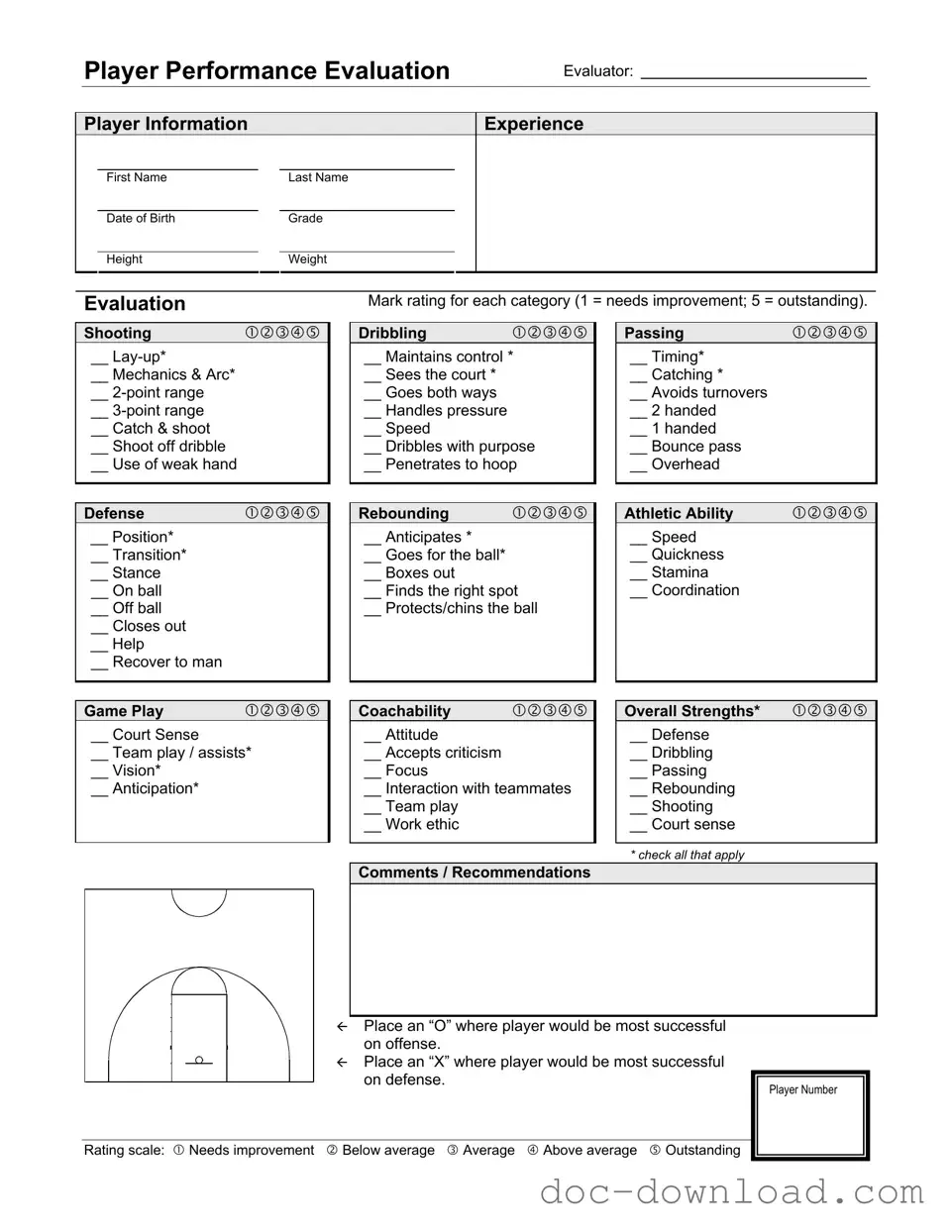The Basketball Evaluation form shares similarities with the Player Performance Assessment commonly used in various sports. Like the basketball form, this assessment evaluates an athlete's skills, strengths, and areas for improvement. It typically includes categories such as shooting accuracy, defensive capabilities, and teamwork, allowing coaches to provide targeted feedback. Both forms aim to enhance player development by identifying specific skills that require attention, thus fostering a more focused training approach.
Another document that aligns closely with the Basketball Evaluation form is the Athletic Skill Assessment. This document serves to evaluate a player's overall athleticism, including speed, agility, and coordination. It often includes a scoring system that mirrors the rating scale found in the basketball form. By analyzing these physical attributes, coaches can determine how well an athlete may perform in various game situations, similar to how the basketball evaluation assesses specific basketball-related skills.
The Individual Player Review is another document that shares common ground with the Basketball Evaluation form. This review provides a comprehensive look at a player's performance over a season or a series of games. It typically includes qualitative feedback alongside quantitative scores, much like the basketball form. Coaches use this document to summarize a player’s growth, strengths, and weaknesses, which helps in crafting personalized training regimens.
In addition, the Skill Development Plan closely resembles the Basketball Evaluation form in its focus on specific skill sets. This document is tailored to outline the areas in which a player excels and those that require improvement. It often includes actionable goals and timelines, similar to the recommendations section of the basketball form. By creating a structured plan, coaches can guide players through their development, ensuring they focus on the right skills at the right time.
For those looking to establish legal clarity and ensure their wishes are respected in times of need, consider this guide to the Durable Power of Attorney form. This crucial document enables you to appoint a trusted individual to make important decisions on your behalf when you are unable to do so. Access the detailed information by clicking on "essential guidance on Durable Power of Attorney" here.
The Game Performance Analysis document also shares similarities with the Basketball Evaluation form. This analysis focuses on a player's performance during actual games, assessing their decision-making, execution of skills, and overall impact on the game. Like the basketball evaluation, it emphasizes specific categories such as shooting, defense, and teamwork, providing a holistic view of a player's contributions during competitive play.
The Coach's Feedback Form is another document that parallels the Basketball Evaluation form. This form allows coaches to provide insights on a player's attitude, work ethic, and ability to accept criticism. It often includes a rating system for various attributes, similar to the evaluation marks in the basketball form. This feedback is crucial for understanding a player's mindset and readiness to improve, thus complementing the technical skills assessed in the basketball evaluation.
The Scouting Report is a document that aligns with the Basketball Evaluation form in its purpose of assessing players. Typically used to evaluate opponents, it can also be adapted for player self-assessment. It includes detailed observations on skills, tendencies, and potential areas for growth. Just like the basketball evaluation, it categorizes skills and provides a framework for understanding a player's strengths and weaknesses in a competitive context.
The Performance Metrics Report is another document that bears resemblance to the Basketball Evaluation form. This report focuses on quantifiable data, such as shooting percentages and assist-to-turnover ratios. While the basketball evaluation emphasizes subjective ratings, the performance metrics report provides objective data that can complement the evaluation process. Together, they create a more comprehensive picture of a player's abilities and contributions on the court.
Lastly, the Training Log can be compared to the Basketball Evaluation form in its role of tracking player progress over time. While the basketball evaluation captures a snapshot of skills at a specific moment, the training log documents daily practice sessions, drills, and improvements. This ongoing record helps players and coaches measure growth, set future goals, and ensure that training aligns with the areas identified for development in the basketball evaluation.

